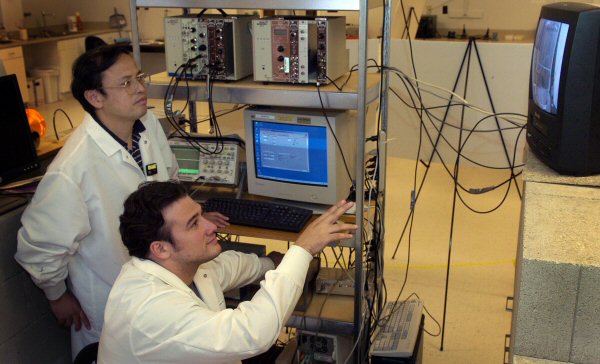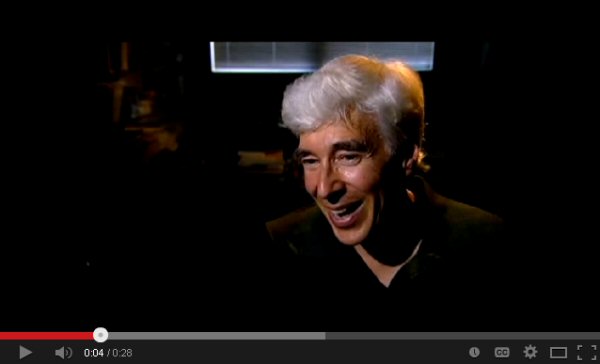Federal Investigations Reveal Academic Backstabbing at Purdue University (Part 4)
Failures to Replicate
One of the novel aspects of the approach used by the Taleyarkhan group was using multi-bubble sonoluminescence rather than single-bubble sonoluminescence, which Putterman had been trying. Among other novel ideas, the multi-bubble approach led to the new evidence by the Taleyarkhan group.
On Oct. 22, 2004, just days after Putterman ran his replication attempt, which failed to duplicate Taleyarkhan’s results, and Putterman posed gleefully with his students for the BBC camera crew, Bertodano sent an e-mail to Tsoukalas and his group at Purdue about the Tsoukalas group’s experiments. Bertodano wrote to Tsoukalas and told him that some of the members of their group had just met and that they had objections to their own confirmatory data, obtained a year earlier.
Sometime in October or November, Putterman pitched an idea to DARPA to attempt a replication of the Taleyarkhan group’s experiment. It was the same type of experiment he had just performed for the BBC — though he almost certainly did not tell DARPA about his failure to replicate — and the BBC had not broadcast Putterman’s failure to replicate.
Back at Purdue, on Dec. 6, 2004, Joshua Walter sent a revision of the Tsoukalas group’s draft paper for NURETH-11 to members of the group. The confirmatory data had been removed. Xu began to write his own paper for NURETH-11.
On Dec. 8, 2004, Tony Tether, the head of DARPA, approved Putterman’s idea of an attempted replication, and DARPA asked for formal proposals. An e-mail from someone at DARPA (the name has been redacted) or the Office of Naval Research spoke highly of Putterman.
“Putterman at UCLA was chosen to lead this effort since he is highly regarded by both DARPA and [Department of Energy],” the author wrote.
Taleyarkhan was still open-minded about working with Putterman in December. Putterman had assured him that he would be fair and respectful with the BBC project. Taleyarkhan went along despite his lingering misgivings and despite Putterman and Suslick’s publicly hostile response to the Taleyarkhan group’s 2002 paper.
Taleyarkhan told New Energy Times that he recalled Putterman’s assurance of good faith in his proposed DARPA-sponsored replication.
“‘If I fail,'” Putterman said, “‘it would be primarily because I am not an able-enough experimenter. I will simply accept that, since I’ve seen the video of the experiment being successfully conducted. Please give me a chance.’
“He said this,” Taleyarkhan wrote, “on the evening of the day before the invited session on Nov. 16, 2004, meeting at the Acoustical Society of America. Putterman also had assured me that his BBC-sponsored work would not be publicized/reported if we would help his group to avoid pitfalls.”
(New Energy Times has published the video that Putterman saw in 2004. Here is the link. We have also published videos of Taleyarkhan demonstrating the experiment at Oak Ridge. Here are the links: 2003 – Nuclear Cavitation Experiment with Normal Acetone and 2003 – Nuclear Cavitation Experiment with Deuterated Acetone.)
Taleyarkhan did not know that Putterman had already done the experiment for the BBC and failed to replicate it. According to e-mails from Brian Naranjo, Putterman’s post-doctoral researcher who worked on the experiment, UCLA sent the final analysis to the BBC on Nov. 5, 2004.
Between Dec. 10 and Dec. 23, 2004, Putterman, Suslick, Taleyarkhan and Larry Crum, a researcher at the University of Washington, submitted a group of proposals for the DARPA replication project. Putterman asked for $5.2 million, Suslick $900,000, Crum $800,000, and Taleyarkhan $1.4 million.
The proposals were accepted, but the researchers got only a fraction of what they asked for. The Office of Naval Research, on behalf of DARPA, issued grant NOOOI4-05-1-0459 to UCLA for the project, and the period of performance began on March 14, 2005. Phase 1 was funded at $812,000, and if it was successful, Phase 2 would have funded at an additional $4,390,000.
After New Energy Times contacted Putterman and Suslick several years ago for comment on an earlier investigation, they asked us not to contact them in the future.
Manuscript Maneuvers
In December 2004, the four scientists had submitted their proposed contracts and sub-contracts to DARPA. Xu had begun to write his own paper for NURETH-11.
On Jan. 13, 2005, Xu, working with graduate student Adam Butt, submitted a different manuscript to Nuclear Engineering and Design.
The following day, on behalf of the Tsoukalas group, Bertodano retracted the group’s NURETH paper.
The NURETH-11 conference organizer was in a bind. He had high hopes that someone would present a paper on the research at NURETH-11. He knew Shripad Revankar personally, so he contacted Revankar and asked whether anyone else at Purdue could provide a paper to report a successful nuclear cavitation replication; Revankar suggested Xu.
BBC Broadcast
Tsoukalas was a supporter of Taleyarkhan’s nuclear cavitation research, at least up to Jan. 19, 2005, as evidenced by his e-mail to BBC producer Murray in which he enthusiastically wrote that his group had performed a successful “bubble fusion” replication. The initial push to remove the positive data from Tsoukalas’ group did not come from him; it came from others in his group.
“Two years ago,” Tsoukalas wrote, “a Purdue group under my guidance and with the assistance of Dr. Taleyarkhan initiated a series of scoping experiments to look for tritium production. … Our raw unpublished results look promising and encouraging. Statistically significant tritium increase appears to be realized from neutron-seeded cavitation tests with chilled deuterated acetone, whereas corresponding tests with normal acetone and those with irradiation alone gave null results.”
The BBC-sponsored experiment aired on Feb. 16, 2005, and Putterman failed to replicate the experiment that he had, three years earlier, publicly disparaged and promised not to replicate. With Putterman’s eager support, the BBC depicted Taleyarkhan’s idea — to a worldwide audience — as a failure and Taleyarkhan as nothing but a dreamer. Putterman appeared as the careful, objective, pleasant scientist, eager to show the public how the scientific method worked. He enjoyed the experience and the $70,000 he got from the BBC, as he explained to the New York Times.
“’I’m desperate for money, and here’s a chance to infuse my laboratory with overhead-free money,’ Dr. Putterman said. ‘We had fun.’”
A month after the BBC broadcast Putterman’s failed replication, Bill Coblenz, a Defense Advanced Research Projects Agency program manager in the Defense Sciences Office, in collaboration with the Office of Naval Research, awarded Putterman and his subcontractors the grant for the DARPA/ONR-sponsored UCLA replication attempt.
Richard Lahey, a member of the Taleyarkhan group who is also a pioneer in the nuclear energy industry, visited Putterman at UCLA after Putterman began. Taking one look at the setup, Lahey told Putterman that his design was “doomed to failure.” (For more information, see the New Energy Times article “Sonofusion Research Scuttled.”)
Second Purdue Replication
On May 3, 2005, three months after the BBC broadcast of Putterman’s failure to replicate, Xu and Butt published the results of their successful nuclear cavitation replication, “Confirmatory Experiments for Nuclear Emissions During Acoustic Cavitation,” in Nuclear Engineering and Design.
On July 5, 2005, the Purdue School of Nuclear Engineering held a Primary Committee meeting and voted on faculty tenure and promotions. Taleyarkhan opposed Tsoukalas’ recommendations. During and/or shortly after that meeting, Taleyarkhan confronted Tsoukalas and told him that he would not go along with his unethical practices. (See following sections: Accusations at Purdue, and Exodus.) This was the beginning of the end of the friendly relationship between Taleyarkhan and Tsoukalas.
A week later, on July 12, 2005, the Purdue News Service issued a press release announcing the successful replication by Xu and Butt. The press release, which was reviewed and approved by Tsoukalas, said the following:
“Xu and Butt now work in Taleyarkhan’s lab, but all of the research on which the new paper is based was conducted before they joined the lab, and the research began at Purdue before Taleyarkhan had become a Purdue faculty member. The two researchers used an identical ‘carbon copy’ of the original test chamber designed by Taleyarkhan, and they worked under the sponsorship and direction of Lefteri Tsoukalas, head of the School of Nuclear Engineering.”
The press release included a photo of Xu and Butt working together on the experiments.

Yiban Xu and Adam Butt
Tsoukalas was pleased with the draft, as he wrote to Emil Venere of the Purdue News Service the night before it was released.
“Thanks,” Tsoukalas wrote. “Very well written indeed.”
Twenty-five minutes later, Venere sent a second draft, and Tsoukalas replied.
“Thanks,” Tsoukalas wrote. “This is a great story, and you did a great job.”
The press release reinforced the fact that Xu and Butt did the work under the direction of Tsoukalas, not Taleyarkhan. It also reinforced the appearance that the replication had been done independently of Taleyarkhan.
The Xu-Butt successful replication had now become a potential public embarrassment for Putterman. In his BBC-TV appearance, Putterman depicted the Taleyarkhan experiment as too good to be true. Now, a post-doctoral researcher, with the help of a graduate student, had confirmed the too-good-to-be-true experiment, and Purdue university was promoting it.
On Sept. 21, 2005, according to Darla Mize, Tsoukalas’ administrative assistant, the School of Nuclear Engineering held another Primary Committee meeting. According to Mize, at this meeting, Taleyarkhan voted against the promotion of Tatjana Jevremovic.
Mize and other school staff have written testimonials about many of the events that took place in the school, which they characterized as “mafia-like.” In these testimonials, they reported details indicating that Tsoukalas and Jevremovic had a romantic relationship.
“That’s when Dr. Tsoukalas really got mad at Dr. Taleyarkhan,” Mize wrote. “It was the beginning of the end of Dr. Taleyarkhan, as far as Dr. Tsoukalas was concerned.”
NURETH-11 Conference
NURETH-11 was coming. By now, the Tsoukalas group had retracted its paper for the forthcoming conference in France. Tsoukalas knew that Xu, Butt and Revankar’s confirmatory paper was to be presented there.
On Oct. 4, 2005, Tsoukalas wrote an e-mail to Jay Gore, the Purdue associate dean of research, and told him that the Xu-Butt-Revankar NURETH-11 paper was the result of multiple breaches of research integrity. Tsoukalas said that Taleyarkhan was the principal author, that Taleyarkhan’s name was intentionally omitted as an author, that Butt had nothing to do with the work, and that Butt’s “name was put on the paper literally in the last minute.”
On Oct. 6, 2005, Revankar presented the paper at the NURETH-11 conference in Avignon, France, on the successful replication experiments led by Xu. The paper was based on work done by Xu, Butt and Revankar, independent of the Tsoukalas group. Revankar had assisted with the work, and neither Xu nor Butt was able to travel to France and present the paper. The Xu-Butt-Revankar successful replication had now become a liability and a potential embarrassment for Tsoukalas. Something had to be done.


